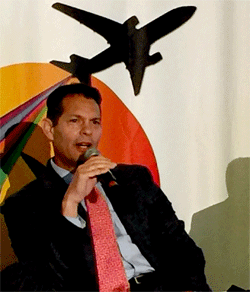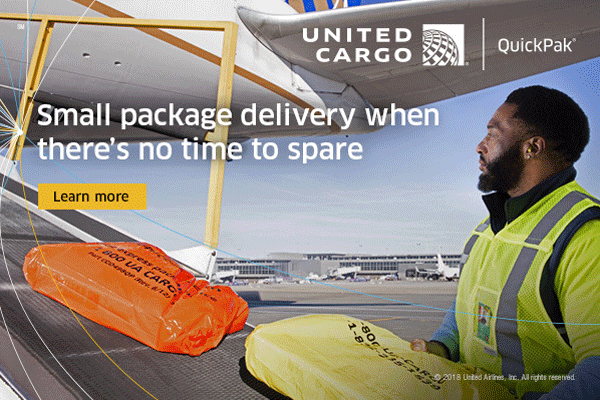|
At last
month’s CNS Partnership Conference, which bannered itself as “Preparing
for Tomorrow’s Reality,” the Airports Council International
– North America (ACI-NA) Air Cargo Committee coordinated a panel
titled “Airport Partnerships: Driving Solutions.”
Considering that all of us are over, under,
around, or through an airport every step of the way in air cargo, maybe
what our world could use right now is a great, informative discussion
of what is happening in places we all share.
Well, guess what? From the endless stack
up of air cargo tradeshows that have happened so far in 2018, the Airport
Partnerships CNS session towers head and shoulders above all of them.
Here is our firsthand report.
Discovering
Columbus - Who Knew?
 Bryan
Schreiber, (right) Manager of Business Development – Air Cargo for
the Columbus Regional Airport Authority, which operates Rickenbacker International
Airport, moderated the panel. Panelists
included Milton de la Paz, Vice President of Airline Relations from Dallas
Fort Worth International Airport (DFW), and David Whitaker – Chief
Commercial Officer for the Columbus Regional Airport Authority, as well
as airport cargo consultant Michael Webber of Landrum & Brown. Bryan
Schreiber, (right) Manager of Business Development – Air Cargo for
the Columbus Regional Airport Authority, which operates Rickenbacker International
Airport, moderated the panel. Panelists
included Milton de la Paz, Vice President of Airline Relations from Dallas
Fort Worth International Airport (DFW), and David Whitaker – Chief
Commercial Officer for the Columbus Regional Airport Authority, as well
as airport cargo consultant Michael Webber of Landrum & Brown.
First Person
Partnership
Bryan Schreiber, who also serves as the
ACI-NA Cargo Committee chairman, acknowledged the ongoing cooperation
between the trade associations. CNS and ACI-NA embody the kind of information
exchange needed at the individual operator level between the largely public
sector U.S. airports and the private sector airlines, handlers, forwarders,
and trucking companies.
“I’d like to express on behalf
of the airport community our appreciation to CNS for including over the
past several years, and now under Michael White, airports in the conference
and seeking ways to extend this partnership,” Schreiber stated.
“No issue on the ground is generally
solvable by one entity, and airports are increasingly aware of their unique
responsibilities.”
Hey Friend,
Do It Again
Evidentiary of this relationship, both Webber
and de la Paz had been panelists in the previous year’s CNS conference,
and Webber hailed the role of CNS and of the Air Forwarders Association
in holding “road shows” in key U.S. markets where airports
need the private sector’s support in elevating awareness of critical
cargo issues. Webber observed that “airport operators are near enough
to the impact of traffic bottlenecks and related issues but often report
to municipal, county, and occasionally state agencies with little or no
such exposure.
“So rather than being received negatively,
airport operators may welcome the public complaints of a motivated private
sector because elected officials often respond more affirmatively to angry
business owners than to well-intentioned bureaucrats.”
 Overview
Brief Overview
Brief
A deep thinker on these matters, Michael
Webber (left) provides a brief overview of cargo challenges confronting
a variety of U.S. airports.
“Because airport operators’
principal investments are in ‘bricks and mortar,’ the standard
master planning horizon is 20-30 years, but must accommodate the needs
of airline and handling tenants whose assets are more portable and whose
planning is often in cycles of weeks and months.
“So airport operators must ensure
that cargo operators have sufficient opportunities to provide input on
cargo facilities planning, but similarly incumbent on the private sector
to take full advantage of those opportunities.
“While on-airport tenants (airlines
and handlers) are relatively reliable to show up for airport-hosted public
meetings on cargo, critical off-airport cargo entities—such as forwarders
and trucking companies—are much more challenging to engage.
“Localized traffic congestion that
often overlaps between municipal roadways and on-airport arteries is an
exemplary challenge for which on- and off-airport cargo operators must
be part of the planning narrative.
“As the bridge between their private
sector tenants’ needs and essential approvals from municipal, state,
and federal departments of transportation (DOTs), airport operators have
a unique facilitation role,” Michael Webber said.
Big D My
Oh Yes!
 From the perspective of one of the world’s
busiest airports, Dallas Fort Worth - DFW’s Milton de la Paz (right)
recalled having fused “interests and efforts of the more airport
operations-centric tenant group that focuses on ramp safety and operations
efficiency with the broader commercial concerns of the DFW Air Cargo Association
(http://dfwaca.com/).”
From the perspective of one of the world’s
busiest airports, Dallas Fort Worth - DFW’s Milton de la Paz (right)
recalled having fused “interests and efforts of the more airport
operations-centric tenant group that focuses on ramp safety and operations
efficiency with the broader commercial concerns of the DFW Air Cargo Association
(http://dfwaca.com/).”
Although the two groups have some members
in common, they historically worked more in parallel rather than finding
intersections of common cause.
A Tale of
Contrasts
“In terms of land, DFW is one of the
biggest airports in North America,” de la Paz noted.
Naturally, this caused panelists to observe the contrasting remedies for
different airports’ cargo challenges.
“At legacy gateways like Los Angeles
International Airport, cargo improvements cannot be undertaken without
complex management of existing assets and operations because some displacement
and accommodation will be required.”
“In contrast, land-rich DFW still
has significant ‘greenfield’ areas that can potentially be
developed for new cargo tenants and next-generation e-Commerce tenants.”
DFW is noteworthy as it is extraordinary
for an airport that ranks in the top five U.S. airports in annual passengers
to also land in the top ten in annual air cargo throughput.
 Hello,
Columbus Hello,
Columbus
Coming from a different angle was David
Whitaker from the Columbus Regional Airport Authority, which oversees
the passenger-focused John Glenn International Airport (CMH) and cargo-oriented
Rickenbacker Airport (LCK.
Whitaker observed that “like land-rich
DFW, LCK has the prerogative of accommodating distribution operations
that might not fit at airports required to prioritize the flows of millions
of passengers.
“Rickenbacker has been successfully
transformed from a former military base to a surging international freight
gateway.
“By design, the Airport Authority
has ensured that its cargo facilities and services—provided by exclusive
fixed-base operator Rickenbacker Aviation—are more than adequate
to accommodate the growth LCK has enjoyed in recent years.”
Easy As ABC
“In April 2018, AirBridgeCargo Airlines
(ABC) became the fifth freighter operator serving LCK, joining Cargolux,
Cathay Pacific Cargo, Emirates SkyCargo, and Etihad Cargo.”
Developing
Alternatives
The panelists discussed LCK’s success
in developing as an alternative to more conventional international cargo
gateways, such as New York’s JFK International Airport and Chicago’s
O’Hare International Airport (ORD).
“LCK’s success is partially
attributable to the operator’s disciplined approach to development—both
in persevering through some lean years and in not overreaching for market
share.”
Success,
Plane & Simple
The Columbus-based management clearly understands
why many carriers and forwarders serve legacy gateways like ORD, but knows
its own market well enough to leverage opportunities driven by local demand,
making LCK into a model worthy of copying—or at least considering.
Like Huntsville before it, Rickenbacker’s
success in developing an alternative gateway looks deceptively simple
from the outside.
Innovation
Stages Drives Conversation
This year CNS tried something different.
Rather than holding an avalanche of concurrent
sessions, new CNS President Mike White opted for conducting meeting sessions
adjacent to the static displays of various companies—a space that
also hosted food services.
The result was an audience that included
members of all the obvious air cargo sectors, as well as facilities developers
and technology vendors.
 For this airport session, audience questions
about complex issues were never likely to produce detailed solutions developed
on-the-spot, but succeeded in inspiring lively discussions.
For this airport session, audience questions
about complex issues were never likely to produce detailed solutions developed
on-the-spot, but succeeded in inspiring lively discussions.
For example, Scott Case, founder of Position:
Global and President of the International Air Cargo Association of Chicago
(https://www.iacac.com/),
suggested airport operators as potential mediators in battles between
forwarders, trucking companies, and handlers with chronic labor and service
issues that ultimately cause congestion at cargo terminals and roadways.
Developer Bob Caton from cargo facilities
developer Aeroterm asked whether the “Guidebook for Air Cargo Facility
Planning & Development” (available for download at http://www.trb.org/Main/Blurbs/173274.aspx)
that Webber co-authored for the Transportation Research Board was still
a reliable resource for airport planners and others.
Webber acknowledged that effort “had
taken surprising turns en route to completion due to the majority of U.S.
airports having surplus capacity due to bankruptcies and acquisitions
of air cargo carriers since the industry’s U.S. peak year of 2000.
“While airports long hoped that these
facilities might provide capacity for new-entry cargo tenants,”
Webber cautioned, “many decades-old cargo facilities are poorly
suited to 21st century users and therefore may be better candidates for
demolition and/or replacement than for reuse.”
Nonetheless, the guidebook reviewed an unprecedented
range of U.S. air cargo facilities and introduced planning nuances (eschewing
“one size fits all” cargo facilities planning metrics) and
at less than five years old, remains a valuable tool for airport planners,
many of whom contacted Webber post CNS to confirm this.
Swarm in
The Warm
Palm Springs may have been 106 in the daytime
during the CNS event, but it was good to see that immediately following
the bright and lively panel discussion, audience members desiring to continue
the deliberations on airport issues swarmed participants.
Vendors of technology solutions touted the
need for better IT integration between on- and off-airport links in the
supply chain.
Potentially working in tandem with physical
improvements such as truck cueing lots, IT solutions are offered as a
means of improving the utilization of capacity where physically expanding
capacity is not much of an option.
And the thought process put in motion here
will undoubtedly continue.
Stay tuned after a definite shout-out to
CNS for proving change and quality presentations are more than an option—they’re
the new reality.
Geoffrey
|







 Vol.
17 No. 33
Vol.
17 No. 33